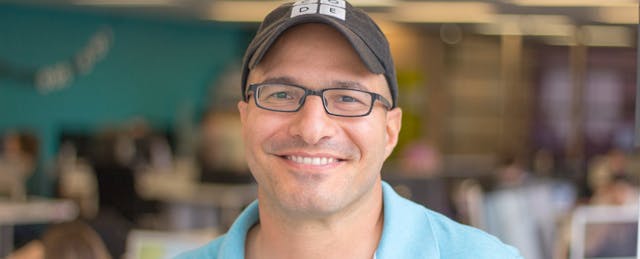The guy who helped create the “Hour of Code,” an event that even got President Barack Obama pecking out a line of JavaScript, almost sounded apologetic.
“Not everyone should ‘code,’” acknowledges Hadi Partovi, CEO and founder of Code.org, in a chat with EdSurge. But everyone should learn to think like a computer scientist, he adds. “We’re about helping schools teach computer science,” Partovi says, namely, to frame questions or information the way that computer scientists do.
Partovi launched the nonprofit Code.org with his brother, Ali, in 2013 to “expand access to computer science,” especially for women and underrepresented students of color. The Partovi brothers had previously run a music service, iLike, before it was snapped up by then high-flier, MySpace. Code.org kicked off with a jazzy video featuring the likes of Bill Gates, Mark Zuckerberg, will.i.am, Ruchi Sanghvi (Facebook’s first female engineer) and others who made coding seem cool. Hadi became the organization’s (unpaid) CEO; Ali stays in the backdrop as an advisor.
These days, running the official annual “Hour of Code,” (slated to take place during Computer Science Education Week, December 5-11) only takes up about 10 percent of the organization’s time, which has an annual budget of $18 million, raised entirely through donations from companies and individuals. “We don’t want to get a dime from schools or from the government,” Partovi asserts.
Partovi estimates that 40 percent of his team’s time has been spent developing their courses and curriculum, aligned to the K-12 Computer Science Framework which launched this week. (The Framework itself wasn't just Code.org's effort; it represents the effort of 100+ organizations, advisors.) Here’s our take on it. Another 40 percent of the group’s time is spent working with more than 120 school districts; so far, they’ve trained 40,000 teachers to teach computer science. The remaining balance of Code.org’s time is spent working on state and federal policies to spread computer science teaching.
Twenty states have changed their policies, with nudges from Code.org, Partovi says; six states around the US are funding computer science. Smaller states are leading the charge, Partovi notes, namely: Arkansas, Alabama, Georgia, Idaho, Rhode Island and Washington. The nation’s littlest state is working hard to be the first in the country to have every school offer computer science. This past year, it trained about half the teachers in its 300 schools. Administrators aim to have all K-12 Rhode Island schools offer computer science by December 2017.
Where will students and schools find the time to add computer science to often-jammed schedules?
Partovi would start by dropping some traditional “tech ed,” including keyboarding or simple web browsing, which he describes as “outdated.” Other subjects, including math, could wrap computer science into their curriculum. Programmable calculators, a 30-year staple of high school advanced math classes, are also relics, he suggests. Instead, math classes could incorporate computer science.
If students got a solid grounding in computer science in their early years, computer science could be handled more like other sciences, such as biology, in high school. “Every kid could learn the foundational elements—and then it’s a tool that applies to everything. Every field could be taught with computer science,” he says. For instance, when students study grammar, they could have the opportunity to build an app that say, works like a MadLibs game or reads back sentences. “They they learn both to code and English,” he adds.
Still he emphasizes that students need not only learn to code—but instead should focus on “procedural thinking,” how to break a problem down into subparts.
“Every field is being impacted by computer science,” Partovi says. Not everyone will become a computer scientist, he says, but understanding the world of data should be a part of education.
“To be a liberal arts major you should know this—it’s like understanding electricity or photosynthesis,” Partovi says. “The point of teaching computer science in K-12 schools isn’t to make students ‘job ready’ but to have a baseline understanding and exposure to computational thinking—so you can choose your path.”
And Partovi’s path? He hopes that Code.org will be successful enough that it can close up shop in five years’ time. His passion for computer science will likely continue though. “This is my life’s mission,” Partovi declares. “It’s gone from being a hobby, to a full time job, to my raison d’etre.”


